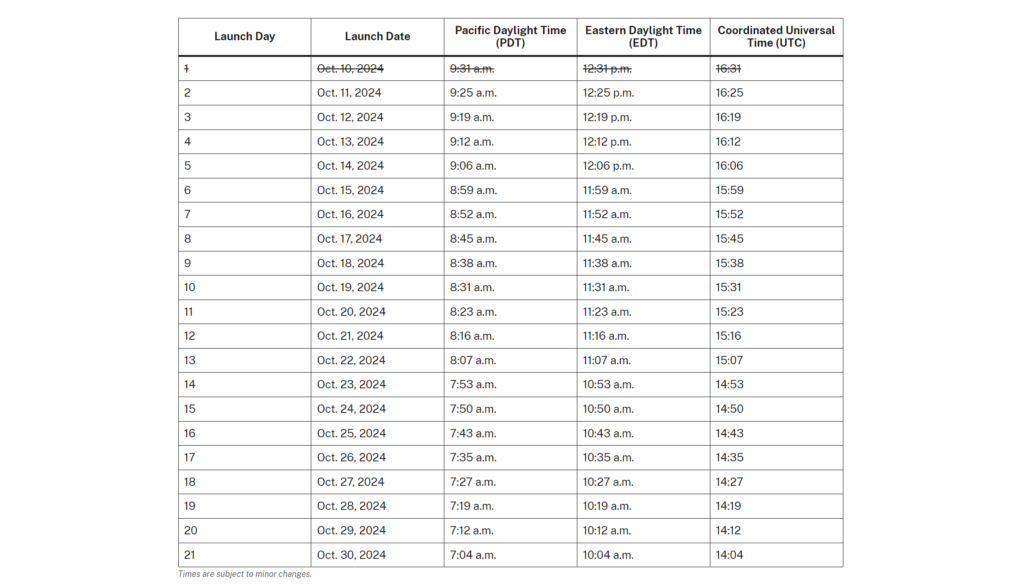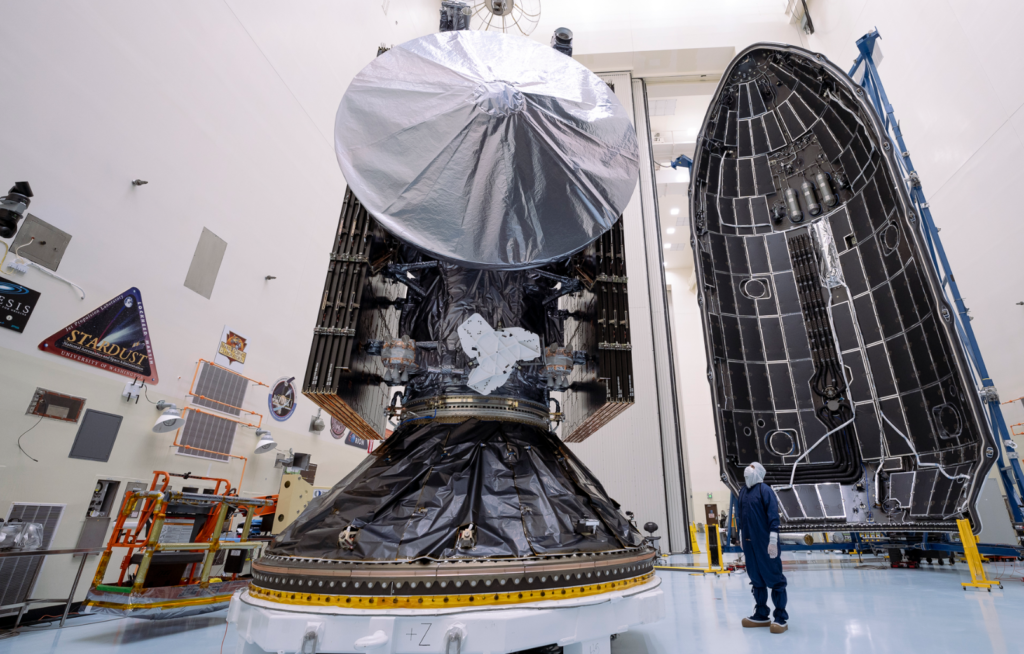Up until a few days ago, the Europa Clipper mission was scheduled to liftoff atop a Falcon Heavy on October 10th, only two days away. This mission has been years in the making with the satellite costing around $5.2 billion in total and taking around a decade to create.
With this in mind, NASA along with SpaceX obviously aren’t willing to take any risks regarding the launch of such an important payload. They also have a valid reason, as Hurricane Milton is expected to make landfall sometime tomorrow and pass right over Cape Canaveral.
Hurricane Delay

Two days ago on the 6th NASA officially released a statement highlighting that they would not be attempting the launch on the 10th. In a tweet, the agency said, ” NASA and SpaceX are standing down from the Oct. 10, launch attempt of the agency’s Europa Clipper mission due to anticipated hurricane conditions in the area. Once the storm passes, recovery teams will assess the safety of the spaceport and the launch processing facilities for damage before personnel return to work.”
Based on these comments it’s clear they expect some possible damage to the spaceport which could impact this launch among others even after the hurricane passes. In a separate more detailed statement they said, “Hurricane Milton is expected to move from the Gulf of Mexico this week moving east to the Space Coast. High winds and heavy rain are expected in the Cape Canaveral and Merritt Island regions on Florida’s east coast. Launch teams have secured NASA’s Europa Clipper spacecraft in SpaceX’s hangar at Launch Complex 39A at the agency’s Kennedy Space Center in Florida ahead of the severe weather, and the center began hurricane preparations Sunday” they said.
Tim Dunn, the senior launch director at NASA’s Launch Services Program mentioned, “The safety of launch team personnel is our highest priority, and all precautions will be taken to protect the Europa Clipper spacecraft. “Once we have the ‘all-clear’ followed by facility assessment and any recovery actions, we will determine the next launch opportunity for this NASA flagship mission,” he said.
Looking at a chart of available launch opportunities provided by the agency, you can see the 10th is crossed off with the other available days going toward the end of this month. While the chart doesn’t include it the launch window actually goes until Wednesday, Nov. 6. It seems realistic that the launch could happen sometime in late October or early November depending on the severity of the hurricane and its impact.
As for the status of the spacecraft, on Oct. 4, workers transported NASA’s Europa Clipper spacecraft from the Payload Hazardous Servicing Facility at NASA’s Kennedy Space Center to the SpaceX Falcon Heavy rocket in the hangar as part of final launch preparations ahead of its journey.
On September 26th, teams connected the Europa Clipper spacecraft to the payload adapter inside the Payload Hazardous Servicing Facility at NASA’s Kennedy Space Center in Florida. With Europa Clipper securely attached to the payload adapter, the team then connected the combined assembly to the payload attach fitting on Monday, Sept. 30.
Teams then detached various coverings that shielded sensitive parts of the spacecraft during processing. Finally, on Wednesday, Oct. 2, teams encapsulated the spacecraft inside Falcon Heavy’s payload fairings, which will protect the spacecraft from aerodynamic pressure and heat during launch. After liftoff, the fairings will separate once the rocket’s second stage climbs high enough, approximately 5 minutes into the flight, and the fairings will return to Earth where SpaceX plans to recover them.
At this point, Europa Clipper still hasn’t been mated to the actual Falcon Heavy rocket. This process was set to happen likely around today however the delays have changed that. When they are ready, technicians will mate the spacecraft to Falcon Heavy, roll the rocket to the launch pad, and raise it to a vertical position ahead of liftoff.
On the 4th SpaceX tweeted saying, “Teams encapsulated NASA’s Europa Clipper spacecraft into Falcon Heavy’s fairing earlier this week ahead of next week’s Falcon Heavy launch from pad 39A in Florida.” This included some images of the massive spacecraft sitting within the fairings. Interestingly the solar arrays you see are folded up and when they are eventually deployed in space, the spacecraft spans more than 100 feet (30.5 meters).
A High Stakes Mission

As partially mentioned prior, the total cost of developing, testing, and creating the Europa Clipper spacecraft has cost an estimated $5.2 billion. Combine this with the mission goal and timeline, and you end up with a launch that rivals the stakes of the James Webb Space Telescope.
The Falcon Heavy was picked thanks to its cost, power, fairing size, and also less obvious features such as reduced launch vibration. In the beginning, NASA was planning on using the Space Launch System (SLS) rocket but ran into a few issues. These main issues being high cost, low availability, and a violent shaking during launch thanks to the solid rocket boosters that could damage the spacecraft. For all these reasons, the agency decided to make the switch to the Falcon Heavy.
The only downside of this switch is the fact that the journey will take longer. Specifically, with the power of SLS, the agency could have launched the satellite on a direct trajectory to Jupiter, resulting in a trip lasting less than 3 years. On the other hand, using Falcon Heavy, Europa Clipper will need to make gravity-assist flybys of Mars and Earth, arriving at Jupiter five and a half years after launch. In other words, assuming it launches this October, it will arrive at its destination in 2030.
As for the spacecraft’s primary objective, its main science goal is to find out whether there are places below the surface of Jupiter’s icy moon, Europa, that could support life. NASA explains that the mission’s three main science objectives are to understand the nature of the ice shell and the ocean beneath it, along with the moon’s composition and geology. The goal is that the mission’s detailed exploration of Europa will help scientists better understand the astrobiological potential for habitable worlds beyond our planet.
In order to do this, Europa Clipper will perform dozens of close flybys of Jupiter’s moon Europa, gathering detailed measurements to investigate the moon. The spacecraft, in orbit around Jupiter, will make nearly 50 flybys of Europa at closest-approach altitudes as low as 16 miles (25 kilometers) above the surface, flying over a different location during each flyby to scan nearly the entire moon.
The mission is hoping to provide a lot of invaluable data. Europa shows strong evidence for an ocean of liquid water beneath its icy crust. Beyond Earth, Europa is considered one of the most promising places where we might find currently habitable environments in our solar system. Europa Clipper will determine whether there are places below Europa’s surface that could support life.
The spacecraft’s payload will include cameras and spectrometers to produce high-resolution images and composition maps of Europa’s surface and thin atmosphere, an ice-penetrating radar to search for subsurface water, and a magnetometer and gravity measurements to unlock clues about its ocean and deep interior. The spacecraft will also carry a thermal instrument to pinpoint locations of warmer ice and perhaps recent eruptions of water, and instruments to measure the composition of tiny particles in the moon’s thin atmosphere and surrounding space environment.
One of the major challenges of this mission is the high radiation. For context, the Jupiter system has some of the most intense radiation in the solar system. To deal with this, most of the spacecraft’s payload and other electronics will be enclosed in a thick-walled vault. This strategy of armoring up to go to Jupiter with a radiation vault was developed and successfully used for the first time by NASA’s Juno spacecraft. The vault walls – made of titanium and aluminum – will act as a radiation shield against most of the high-energy atomic particles, dramatically slowing down degradation of the spacecraft’s electronics.
It’s worth noting that in the past few months, there were some concerns with the spacecraft’s ability to withstand the radiation. In a quote, the agency said, “Engineers with NASA’s Europa Clipper mission continue to conduct extensive testing of transistors that help control the flow of electricity on the spacecraft. NASA’s Jet Propulsion Laboratory in Southern California, which manages the mission, began the tests after learning that some of these parts may not withstand the radiation of the Jupiter system, which is the most intense radiation environment in the solar system” they said.
Since then they have completed more tests and are confident that the spacecraft is capable and ready to launch, when that window becomes available. To put it in perspective, the Jupiter system is particularly harmful to spacecraft as its enormous magnetic field, which is 20,000 times stronger than Earth’s magnetic field, traps charged particles and accelerates them to very high energies, creating intense radiation that bombards Europa and other inner moons. This is one of the main reasons the spacecraft will conduct flybys to try and avoid too much radiation exposure.
NASA points out that the mission is currently planned to conduct four years of science observations at Europa. Ideally, it survives longer and provides even more data. Before that, however, we need a launch opportunity to open and a successful Falcon Heavy mission.
Conclusion
Due to Hurricane Milton the launch of the Europa Clipper Spacecraft has been delayed from the 10th to an unknown date. NASA and SpaceX have launch opportunities going all the way until November 6th which should be plenty of time.
